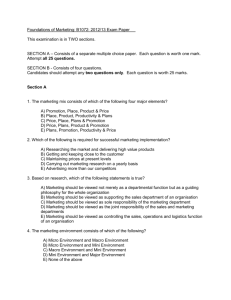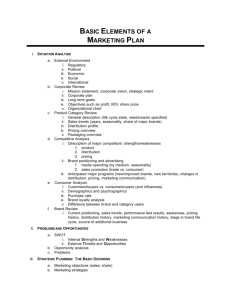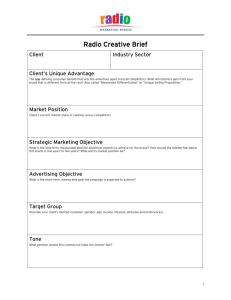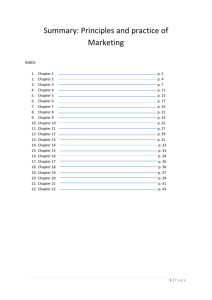B1072 Foundations of Marketing
advertisement
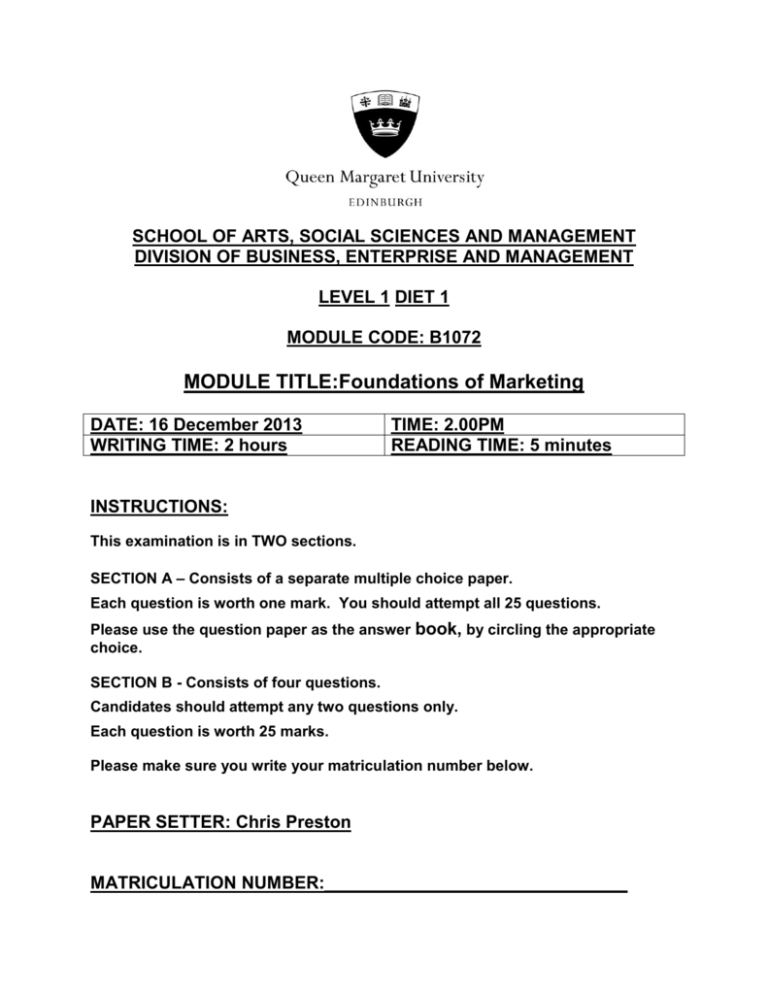
SCHOOL OF ARTS, SOCIAL SCIENCES AND MANAGEMENT DIVISION OF BUSINESS, ENTERPRISE AND MANAGEMENT LEVEL 1 DIET 1 MODULE CODE: B1072 MODULE TITLE:Foundations of Marketing DATE: 16 December 2013 WRITING TIME: 2 hours TIME: 2.00PM READING TIME: 5 minutes INSTRUCTIONS: This examination is in TWO sections. SECTION A – Consists of a separate multiple choice paper. Each question is worth one mark. You should attempt all 25 questions. Please use the question paper as the answer book, by circling the appropriate choice. SECTION B - Consists of four questions. Candidates should attempt any two questions only. Each question is worth 25 marks. Please make sure you write your matriculation number below. PAPER SETTER: Chris Preston MATRICULATION NUMBER:_______________________________ SECTION A 1. When does customer satisfaction occur? A) Customer satisfaction occurs when perceived performance matches or exceeds competitors offering. B) Customer satisfaction occurs when perceived performance matches or exceeds expectations C) Customer satisfaction always occurs when the customer obtains a product for a value price D) Customer satisfaction occurs when there are no complaints E) Customer satisfaction occurs when customers continue to purchase 2. Which of the following does the promotional mix not control? A) Sales Promotions B) Public Relations C) Trade Discounts D) Direct Marketing E) Online Marketing 3. Service marketers have argued for a 7-Ps approach for their marketing mix. Which of the following are the 7 P’s? A) Place, Product, Promotion, Planning, Price, People, Process B) Place, Product, People, Productivity, Promotion, Process, Planning C) People, Promotion, Price, Process, Physical Evidence, Product, Place D) People, Place, Price, Process, Planning, Product, Physical Evidence E) None of the above are the service marketing 4P’s 4. Which of the following is not required for successful marketing implementation? A) Organizational structure that must reflect marketing strategy B) Understanding and responding to customers C) Meet needs better than competitors D) Matching what your competitors offers both in terms of price and features E) Clear communication of strategy 5. Based on research, which of the following statements is true? A) Marketing should be viewed not merely as a departmental function but as a guiding philosophy for the whole organization B) Marketing should be viewed as supporting the sales department of an organisation C) Marketing should be viewed as sole responsibility of the marketing department D) Marketing should be viewed as the joint responsibility of the sales and marketing departments E) Marketing should be viewed as controlling the sales, operations and logistics function of an organisation 6. The marketing environment consists of which of the following? A) Micro Environment and Macro Environment B) Micro Environment and Mini Environment C) Macro Environment and Mini Environment D) Mini Environment and Major Environment E) None of the above 7. Demographic forces affect which of the following? A) Changes in price B) Changes in population C) Changes in technology D) Changes in the marketplace E) Changes in climate 8. Corporate social responsibility refers to which of the following? A) Refers to the ethical principle that a person or an organization should be accountable for how its acts might affect the physical environment and the general public B) Refers to that companies need to be aware that they have a responsibility to society and to meet their minimum legal responsibilities C) Refers to companies having “to be seen to be green” in their policies, processes and products D) Refers to companies have to meet all national and international environmental regulations E) Refers to companies who engage in philanthropic activity 9. In a consumer situation, the search may be internal or external. Internal search involves which of the following? A) Involves reviewing whether the person has the product already B) Asking friends, relatives and peers about a product/service C) Involves a review of relevant information from memory D) Finding out about a product/service through salespeople E) Asking immediate family and friends about a product /service 10. The degree of perceived relevance and personal importance accompanying the brand choice is called which of the following? A) Involvement B) Risk factor C) Selection D) Choice criteria E) Perception 11. The process that groups consumers according to their beliefs, activities, values and demographic characteristics such as education and income is called which of the following? A) Demographics B) Psychographics C) Profiling D) Categorisation E) Econometrics 12. When the researcher actively collects new data, for example by interviewing respondents, this is called which of the following? A) Primary Research B) Secondary Research C) Exploratory Research D) Respondent Research E) Collective Research 13. Qualitative research aims to establish which of the following? A) Aims to establish sales, profit and market share levels within an industry B) Aims to establish sales and market share levels within an industry C) Aims to establish customers’ attitudes, values, behaviour and beliefs D) Aims to establish competitors’ attitudes, values, behaviour and beliefs E) All of the above 14. The group leader who manages the discussion within a focus group is called which of the following? A) An integrator B) A regulator C) An accommodator D) An interpreter E) A moderator 15. What is the purpose of segmentation? A) To identify differences in behaviour that have implications for marketing decisions B) To identify the most profitable consumer segments C) To target segments that are not targeted by competitors D) To target segments which match our product/service attributes E) To target and identify segments which are not catered for at all 16. A differentiated target marketing strategy exploits which of the following? A) Exploits the differences between competitors prices B) Exploits the differences between marketing segments C) Exploits the apathy of consumers D) Exploits the new trends, fads and fashion E) Exploits consumer’s value consciousness 17. Which of the following is not a benefit of branding? A) Consumers find it easier to recognise B) Ability to charge price premiums C) Achieving distribution more readily D) Sustaining high and stable sales and profits through brand loyalty E) All of the above are benefits of branding 18. The element that makes the brand distinctive from other competing brands such as symbols, features, images and relationships is referred to as which of the following? A) Brand association B) Brand assets C) Brand reflection D) Brand association E) Brand value 19. According to the BCG matrix, “Cash Cows” are described as which of the following? A) These are the market leaders in high growth markets B) These are products with a high market share in low growth markets C) These are products which have absorbed large amounts of cash in their launch, however little or no gains have been made in terms of market share D) These are weak products that compete in low growth markets E) These are products which are absorbing large amounts of advertising cash due to stagnant growth 20. Which of the following is not a unique characteristic of services? A) Conditionality B) Intangibility C) Variability D) Inseparability E) Perishability 21. Where companies set their prices at levels either above, the same as or below their competitors, this is called? A) A cooperative B) A cartel C) Price fixing D) Benchmarking E) None of the above 22. Which of the following is a weakness associated with competitor-oriented pricing? A) Competitor-oriented pricing is risky where a firm’s cost position is weaker than its competitors B) Competitor-oriented pricing lets competitors dictate prices, therefore a loss of reputation as a market leader may emerge C) Competitor-oriented pricing doesn’t take into account economic conditions that may affect pricing decisions D) Competitor-oriented pricing is too simplistic and easy to use E) Competitor-oriented pricing is banned under European price fixing legislation 23. Direct response advertising differs from traditional advertising because of which of the following reasons? A) As they use different media vehicles B) Direct response advertising relies on the hard sell approach C) As it is designed to elicit a direct response such as directing to website, or forwarding telephone number D) As the average direct response adverts are 30 minutes long whereas traditional advertising is 30 seconds E) There is no real difference between traditional advertising and direct response advertising 24. Where publicity is generated from word of mouth recommendations on the Internet or email, this is referred to as which of the following? A) Spam mail B) E-mail publicity marketing C) Viral marketing D) Review marketing E) Direct marketing 25. Market development is best described as which of the following? A) Existing products in new markets B) Existing products in existing markets C) New products for new markets D) New products for existing markets E) None of the above SECTION B Attempt any two questions only. Each question is worth 25 marks. Please begin each answer on a new page. 1. The 7P marketing mix consists of elements that provide the marketer with a range of activities by which competitive advantage can be gained. Outline these elements and the roles they perform 2. Explain the role of marketing research to the marketer and explain the relationship between research information and consumer orientation, illustrating your answer with examples 3. What is meant by digital marketing, and how does it differ from more traditional marketing techniques. 4. Discuss the marketing of products and the marketing of services, and outline the similarities and differences END OF EXAM PAPER
